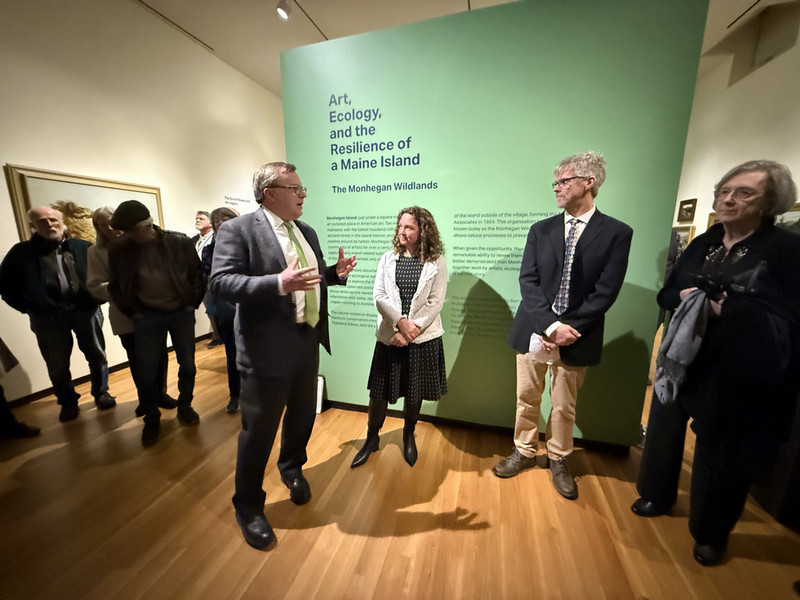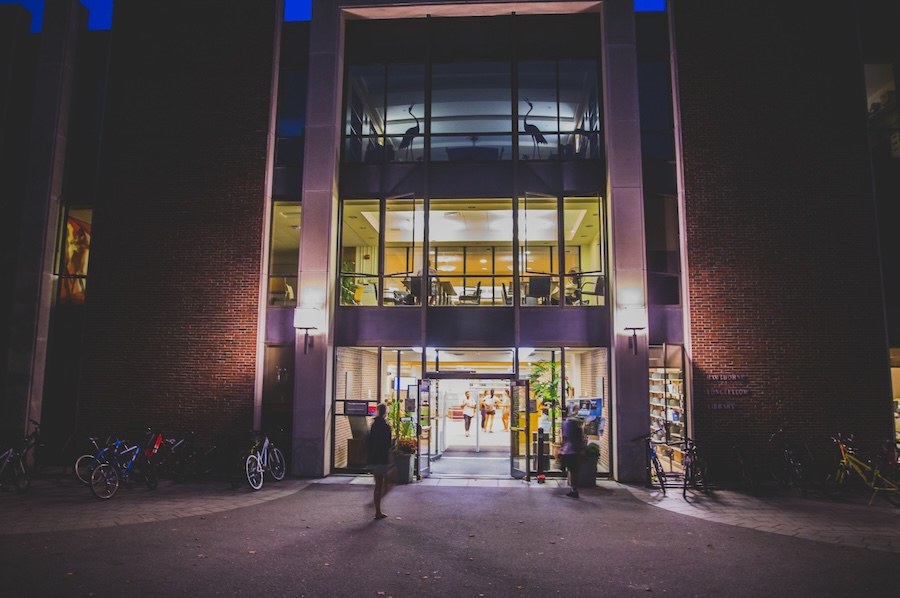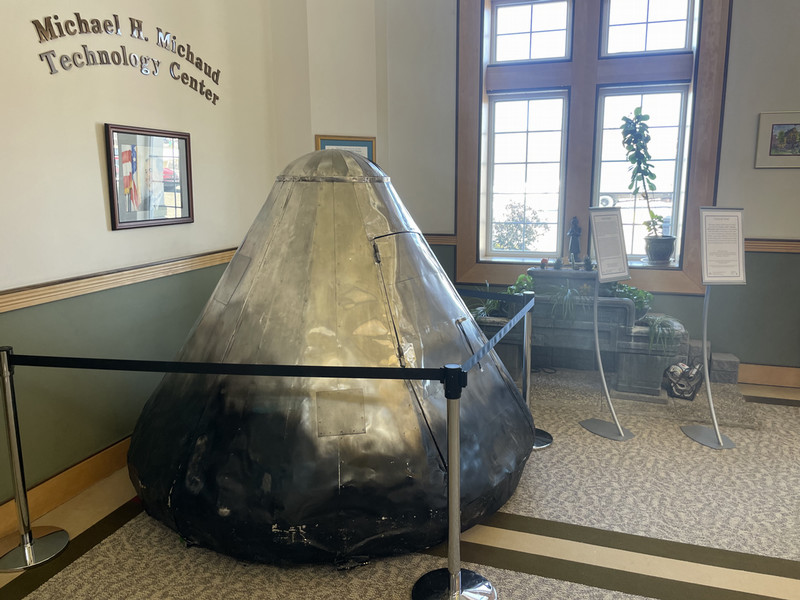Major Painting by Bolivian and Aymaran Modernist Alejandro Mario Yllanes Is Acquired by Museum of Art
By Anne Collins Goodyear, Co-Director, Bowdoin College Museum of ArtBowdoin College Museum of Art becomes first American museum to acquire a painting by Alejandro Mario Yllanes.
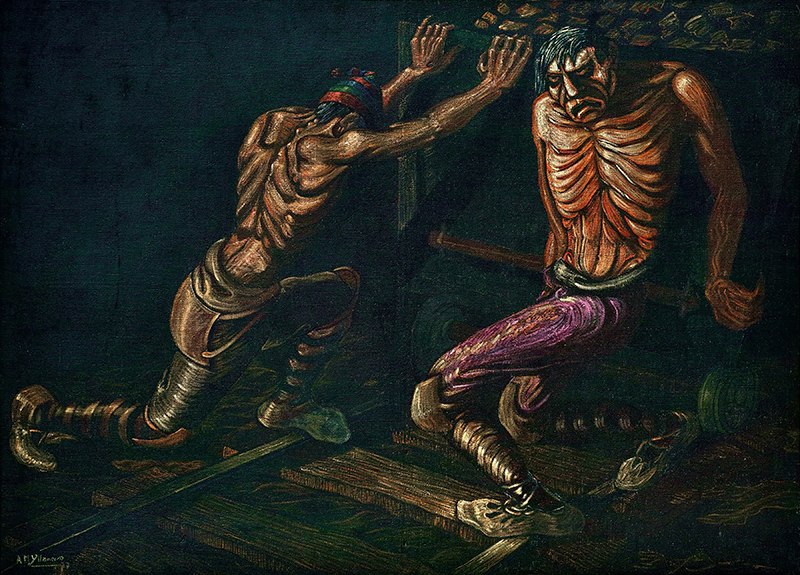
Estaño Maldito (Cursed Tin), 1937, oil on burlap by Alejandro Mario Yllanes, Bolivian and Aymara, 1913–ca. 1960. 60 x 77-1/2inches (142 x 197 cm). Bowdoin College Museum of Art, Museum Purchase, Lloyd O. and Marjorie Strong Coulter Fund.
On March 5, the Bowdoin College Museum of Art looks forward to unveiling publicly two important works by the Bolivian modernist Alejandro Mario Yllanes: Estaño Maldito (Cursed Tin), a monumental painting made in 1937, and Elegia (Elegy), a wood engraving of 1944. While executed in different media and at different scales, both works shared a common goal: bringing visibility to the exploitation of the Indigenous communities of Bolivia and across Latin America by American and European interests. Of Aymaran descent himself, Yllanes personally experienced in his youth, after the early death of his parents, the brutal conditions of tin mining depicted in his canvas. The work’s vivid colors and large scale, its inclusion of the striped cap and striped stockings associated with Aymaran clothing, and the sculptural qualities of the sinewy bodies and facial features included in the composition point to the deliberate intersection of modern muralism and Bolivia’s pre-Hispanic Tiwanaku culture to create a “tahuanacota” style deliberately referencing the heritage of the artist’s ancestors. Acknowledging his own familiarity with the conditions his work reflects, Yllanes paints himself into the composition, his grimacing face testifying to the anguish of this experience and the predicament of others facing the same circumstances. His features similarly appear in the foreground of Elegia, pointing up the senseless deaths of impoverished Bolivian workers. In his hand, Yllanes includes a glass of spirits, pointedly alluding to the role of alcohol in subduing and destroying Indigenous laborers. Testifying to the enduring importance of their cultural achievements, the “stepped” border of Yllanes’s Elegia recalls Tiwanaku architecture.
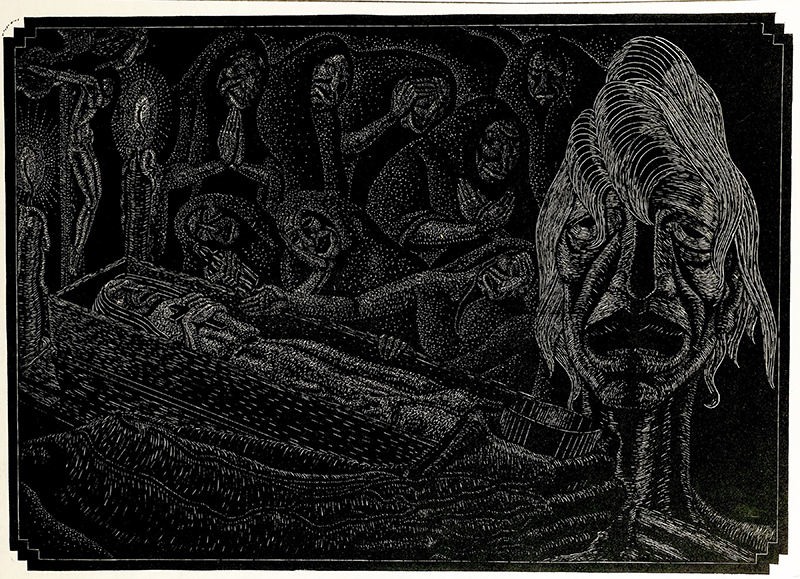
Elegia, 1944, wood engraving, by Alejandro Mario Yllanes, Bolivian and Aymara, 1913–ca. 1960. 14 x 18 inches (36 x 46 cm). Bowdoin College Museum of Art, Gift of Ben Elwes Fine Art, London and Martin du Louvre, Paris.
Originally trained in the law, Yllanes turned to a career in the fine arts to further his commitment to advocating on behalf of Indigenous communities. Recognized and admired by his contemporaries, the artist showed his work throughout Latin America, coming to the attention of Mexican muralists including José Clemente Orozco, David Alfaro Siqueiros, and Diego Rivera. Sharing their commitment to a socially conscious art, Yllanes worked at a scale that would ensure his canvases and murals could easily be seen by audiences, and he simultaneously worked in prints, creating multiples that could be easily disseminated.
Yllanes’s Estaño Maldito was painted in the wake of the Chaco War (1932–1935), a proxy conflict waged between Bolivia and Paraguay at the behest of the US company Standard Oil and British and Dutch company Royal Shell. Bolivia’s defeat further undermined an unstable government rendered vulnerable to a volatile tin market, especially with reduced demand after World War I. The work, painted on burlap, was executed during a period of political exile for the artist. Yet the canvas would attain a great deal of visibility after its completion—as demonstrated by its reproduction in Mexican and Peruvian newspapers and its inclusion in a 1946 exhibition at the Palacio de Belles Artes (Palace of Fine Arts) in Mexico City sponsored by the Mexican secretary of public education and the artists Rivera, Orozco, and Siqueiros.
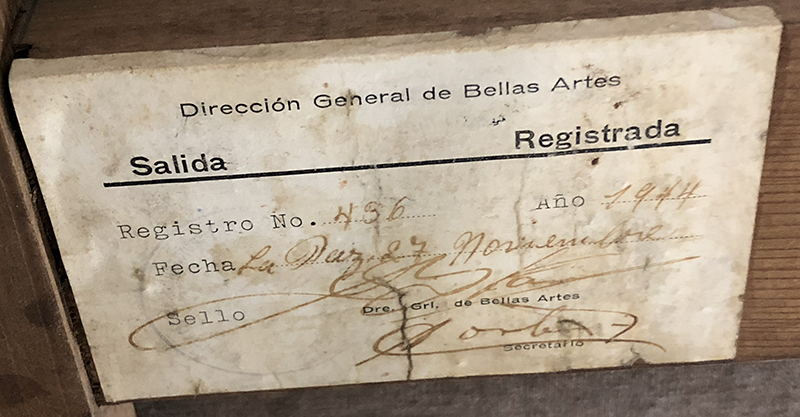
A 1944 registration tag from the Palacio de Belles Artes in Mexico City on the back of Yllanes's Estaño Maldito.
Documentation related to this event remains with the painting in the form of a label still visible on the painting’s stretcher. At the time of this exhibition, and with the shift in political regimes, the artist was once again in the good graces of the Bolivian government and served as a cultural attaché to Mexico. The strength of the show was such that the Mexican government awarded the Bolivian artist its prestigious Gold Medal.
In 1946, Yllanes brought the canvas and other works with him to the United States, when he served as a Bolivian delegate to the American Congress of Professors. Remaining in the United States, Yllanes found his art was admired by American institutions, with curators at the Brooklyn Museum, the New York Public Library, and the Museum of Modern Art acquiring examples of his prints for their collections. Indeed, Yllanes’s prestige was such that he received a Guggenheim Fellowship in 1948 for the purpose of studying and comparing the art of Indigenous communities in North and South America. However, after this award, the artist’s story becomes hazy. Although his biography continued to be included in Who’s Who in American Art until 1960, no historical records are known to exist about his activities after the fall of 1948, raising critical questions about his fate.
But, if Yllanes disappeared from the American art world prematurely, a powerful legacy survives in the work he left behind. Stewarded initially by his landlords, the work was later acquired by private collectors. Shown in 1992 in two exhibitions in New York City, the work recently resurfaced and has begun to stimulate new scholarship. This includes important work by Michele Greet ’93, a highly regarded expert in Bolivian and Latin American modernism, whose career as a scholar began at Bowdoin, where she was a Romance language major (French and Spanish) and a Latin American studies minor. According to Greet, who recalls being galvanized by Latin American art while studying abroad in Ecuador during her junior year, “Yllanes has for too long remained an obscure figure in the history of modern art, overshadowed by peers. While this is no doubt in part because of his mysterious disappearance, Estaño Maldito reveals his aptitude as both artist and activist. Having learned the concept of “indigenismo,” promoted by Latin American philosopher José Carlos Mariátegui, Yllanes saw an opportunity to express these ideas, to advocate for Indigenous communities, through his art. Across his known body of work, whether paintings or works on paper, his subjects are passionately portrayed and boldly figured. And, while they evidently fit within a Latin American tradition, Yllanes had a style and approach that was very much his own.” In addition to restoring public attention to an exceptionally talented artist, this acquisition also opens up historiographic questions, challenging us to consider how and why we have built certain conclusions about earlier generations of artists. As Greet explains: “Scholarly focus on artistic production at the Academy [Academía de Bellas Artes (the Academy of Fine Arts) in La Paz, Bolivia] has left little room for figures like Yllanes, whose clashes with the government and frequent absences from the country situated his work outside official narratives.” What does it mean, then, for historians to reconsider the very mechanisms through which we construct the stories we tell about the past and those talents we deem transformative?
Bowdoin’s acquisition of Yllanes’s work represents an important complement to the Museum’s existing collections, even as it enables us to bring to light a major, if previously overlooked, modernist talent. The first works by a Bolivian (and Aymaran) artist to enter the collection, Yllanes’s painting and engraving resonate with contemporary Latin American artists over the past several years, including sculptures by Celia Vasquez Yui (Shipibo-Conibo and Peruvian), a painting by Sergio Miguel (Mexican), drawings by Josefina Auslender (Argentine), and photographs by Adrián Balseca (Ecuadorian), Fidel Carrillo (Peruvian), Martine Gutierrez (Mexican), Mayu Mohanna (Peruvian), and Sergio Urday (Peruvian). Estaño Maldito will also help to amplify the impact of other depictions of metal mining in the BCMA’s holdings by a host of other artists, including Emmet Gowin’s Mining Exploration, Utah, 1988; Edward Burtynsky’s Silver Lake Operations, #1, Lake Lefory Western Australia, 2007; Sebastião Salgado’s Serra Pelada, Brazil (Cast of Thousands), 1986 (printed 2004); Frederick Sommer’s Gold Mine, Arizona, 1943; and David Maisel’s Ore Concentrator, Copper Mines, Clifton, Arizona, 1985.
The Museum’s acquisition of Yllanes’s work was supported by a number of faculty members. Carolyn Wolfenzon, associate professor in Romance languages, notes: “As a Hispanic studies professor, I am interested in showing and explaining the location of mines in the Andean region.” Túlio Resende Baêta Zille, visiting assistant professor in government and legal studies, observes: “Translated as ‘damned tin,’ or ‘cursed tin,’ [Estaño Maldito] highlights the exploitation of Indigenous labor in Bolivia, which finds resonances throughout colonial and postcolonial Latin America. This piece is also quite contemporary, given ongoing exploitation of minerals in Latin America, which is only worsening due to a rising demand for minerals used in transitions to ‘clean’ energy.”
Estaño Maldito, the first painting by Yllanes to enter an institutional collection in the United States, and his print, Elegia, testify to the Museum’s commitment to build and disseminate new knowledge by bringing into its collection work that challenges traditional canonical understanding of the development of the history of art. In sharing with the public Yllanes’s remarkable talent, the Museum is able to broaden in important ways our understanding of the development of international modernism, including the relationship between Latin America and the United States. By bringing Yllanes’s fascinating—and unfinished—story to light, we are also able to open important new questions about the relationship of art to politics and to demonstrate the power of an artist’s undying commitment to his craft in rendering visible the stories of his own era that deserved to be shared. We look forward to the new insights Yllanes’s work can help to stimulate going forward.

